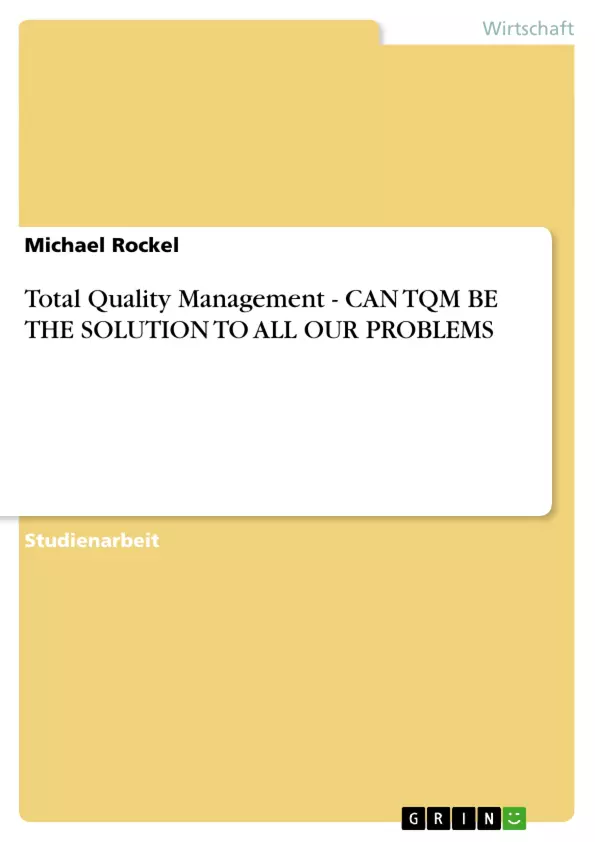1 Introduction
In contemporary business environments with an increasing degree of globalization and international supply relationships there is a growing demand for comparable quality standards. More and more buying decisions are not only based purely on the attributes of the product itself but also on the quality standards of the organization that produces it. Accredited companies tend to by their products only form accredited ones. The ever increasing quality-focus made quality become a constant element of the marketing-mix and a strategic success factor (Anonymus, 2002). The implementation and application of Total Quality Management (TQM) has become a philosophy for most of today’s companies. The following essay will outline the main elements of TQM, describe implementation processes and evaluate the needs and threats of TQM. [...]
Inhaltsverzeichnis
- Introduction
- What causes the need to adapt our company?
- What can TQM do in this case?
- Definitions
- Quality
- Definition and Development of TQM
- The concept of TQM
- The TQM Model
- Main Aspects of TQM
- Employee-orientation
- Customer-orientation
- Constant improvement
- The quality standard ISO 9000
- Why do we need TQM?
- Quality-related-cost
- Prevention Cost
- Appraisal Cost
- Failure Cost
- Influence of TQM on the total quality cost
- Consumer benefit
- Company benefit
- Quality-related-cost
- How can TQM be implemented
- Identification tools
- Tools for the implementation
- Identification and analysis tools
- TQM implementation phases
- Analysis-phase
- Design-phase
- Realisation-phase
- Maintenance-phase
- Main problems for the implementation of TQM
- Management
- Employees
- Implementation traps
- Identification tools
- Success Factors of TQM
Zielsetzung und Themenschwerpunkte
Diese Arbeit untersucht die Implementierung von Total Quality Management (TQM) als Strategie zur Verbesserung von Unternehmensleistung und zur Bewältigung der Herausforderungen des modernen Geschäftsumfelds. Sie analysiert die theoretischen Grundlagen und praktischen Anwendungen von TQM, einschließlich seiner wichtigsten Aspekte, Erfolgsfaktoren und potenziellen Implementierungsprobleme.
- Die Bedeutung und Definition von TQM
- Die Anwendung des TQM-Modells in der Praxis
- Die Herausforderungen der TQM-Implementierung und ihre Überwindung
- Die Beziehung zwischen TQM und Qualitätssicherung durch Standards wie ISO 9000
- Die Vorteile von TQM für Unternehmen und Kunden
Zusammenfassung der Kapitel
- Introduction: Dieses Kapitel beleuchtet die aktuellen Herausforderungen, denen Unternehmen im heutigen Wettbewerbsumfeld gegenüberstehen, und stellt die Bedeutung von TQM als möglicher Lösungsansatz heraus.
- Definitions: Dieses Kapitel liefert grundlegende Definitionen von Qualität und Total Quality Management. Es verfolgt die Entwicklung von TQM von seinen Anfängen bis zu seiner gegenwärtigen Bedeutung in der Unternehmenspraxis.
- The concept of TQM: Dieses Kapitel stellt das TQM-Modell vor und erläutert seine wichtigsten Aspekte, einschließlich der Betonung von Mitarbeiter- und Kundenorientierung sowie kontinuierlicher Verbesserung.
- The quality standard ISO 9000: Dieses Kapitel untersucht die Bedeutung von ISO 9000 als international anerkannten Qualitätsstandard und zeigt die Beziehungen zwischen ISO 9000 und TQM auf.
- Why do we need TQM?: Dieses Kapitel beleuchtet die Vorteile von TQM für Unternehmen und Kunden. Es untersucht die Kosten von schlechter Qualität und zeigt, wie TQM diese Kosten reduzieren und die Gesamtqualität verbessern kann.
- How can TQM be implemented: Dieses Kapitel befasst sich mit der praktischen Implementierung von TQM. Es analysiert wichtige Phasen der Implementierung, identifiziert mögliche Hindernisse und bietet Strategien zur Überwindung dieser Herausforderungen.
Schlüsselwörter
Total Quality Management, TQM, Qualitätsmanagement, ISO 9000, Qualitätsstandards, Kundenorientierung, Mitarbeiterorientierung, kontinuierliche Verbesserung, Unternehmensleistung, Kosten von schlechter Qualität, Implementierung, Erfolgsfaktoren, Herausforderungen, Management, Mitarbeiter.
- Quote paper
- Michael Rockel (Author), 2004, Total Quality Management - CAN TQM BE THE SOLUTION TO ALL OUR PROBLEMS, Munich, GRIN Verlag, https://www.grin.com/document/35877



